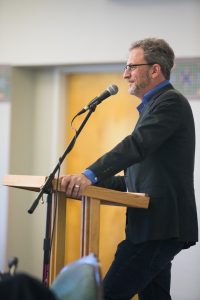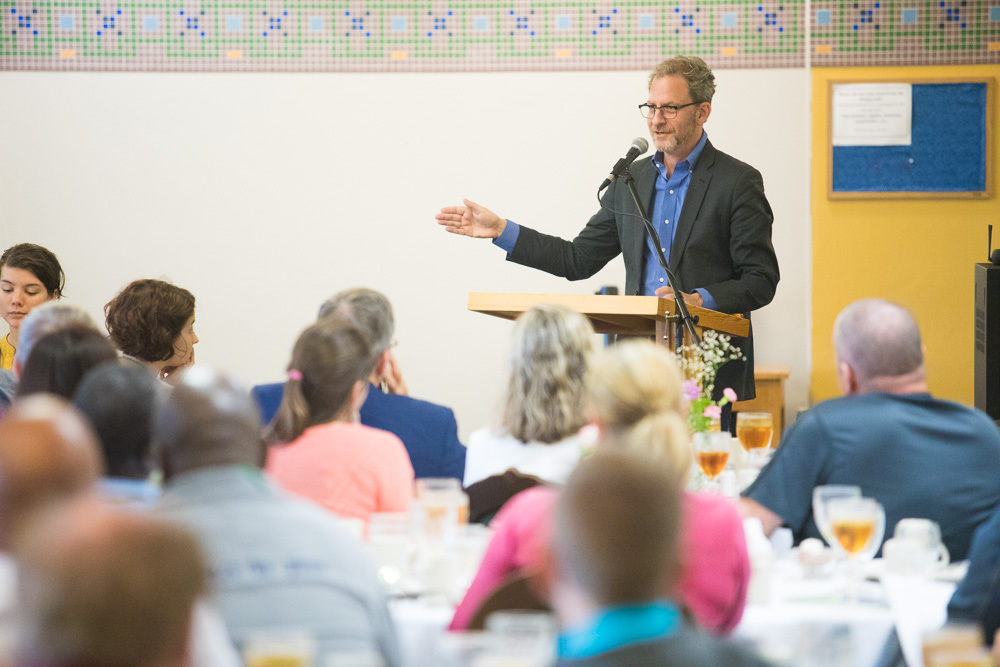Civil rights attorney Ari Wilkenfeld has spent all of his professional life in the combative, confrontational world of litigation, where even settlements out of court are hard-fought battles.
In a corner of his office, he keeps a collection of baseball bats, one for each case he has won in court.
A partner in the Washington D.C.-based firm Wilkenfeld, Herendeen & Atkinson, he currently has two high-profile cases, as representation for the first woman to accuse former NBC news anchor Matt Lauer of sexual misconduct, and also the accuser of NBC news journalist Tom Brokaw.
While he finds victim legal advocacy challenging and fulfilling, he says, a recent visit to speak at Eastern Mennonite University’s Summer Peacebuilding Institute created an “eye-opening,” self-reflective awareness.
That “unique experience” exposed “the world that I live in,” which stigmatizes the possibilities, process and potential of collaborative conflict resolution, he said in a phone interview a few days later. “I’ve studied truth and reconciliation as it was conducted in South Africa, and taught negotiation and diplomacy in college and law school, but I have never had the opportunity to have my manner of doing my job challenged by a group of people who have different ideas about conflict resolution, and not just different ideas but carefully studied and well-thought-out ideas.”
An ‘eye-opening’ context
Many SPI participants – and not just those attending this year’s first-time course offering on sexual harms – bring a nuanced understanding of issues related to gender-related violence, says Bill Goldberg, SPI director.
Many peacebuilders at SPI, women and men alike, work to further the goals of United Nations Security Council Resolution 1325, known as UNCR 1325. It codified the importance of women’s participation at all stages of peace processes and called for increased measures to reduce gender-based violence during armed conflict.

“Increased gender-based violence and inequalities are common symptoms of fragile states, which is why global attention is much more attuned to this issue,” Goldberg said. “The United States delayed development of its required action plan related to UNCR 1325 for 11 years, which says something about how little our political leadership cares about this issue. The grass-roots efforts of the #MeToo and Time’s Up movements reflects on issues of global importance.”
As Wilkenfeld said during his visit, “we live in a country that about every 50 years for 3.5 weeks cares about what women need.”
Beyond the ‘baseline’
Wilkenfeld was a guest in a course titled “Sexual Harms: Changing the Narrative.” Course creator and facilitator Dr. Carolyn Stauffer brings her own expertise from 30 years working on issues of gender-based violence in South Africa, the Middle East and the United States.
While noting the importance of compliance with legal standards, Wilkenfeld challenged participants to reach beyond this baseline towards aspirational goals, Stauffer said.
“He pointed out that most legal standards are more than 50 years old and we should be rigorously notching up minimum requirements,” she said. “Course participants suggested that this should be the case in terms of how we define what constitutes sexual harms, how organizations practice truth-telling and public apology, as well as in understanding differential impacts across various communities.”
Stauffer said she was “impressed with the depth and nuance of the dialogue, a conversation that would not have gained this level of visibility, even five years ago.”
Both challenged and challenging
Wilkenfeld then addressed all SPI participants and other guests as the featured speaker during a Horizons of Change luncheon. He summarized his work and offered remarks on the #MeToo movement for about 15 minutes before opening the floor for questions and discussion.
In a workplace environment with a pervasive culture of sexual harassment, he said, systemic change can begin with the individual through acknowledgement of male privilege, calling out inappropriate behavior, entering into honest conversations and taking responsibility for one’s actions. [Read his December 2017 Washington Post op-ed urging men “to face the mirror.”]
In response to audience questions, Wilkenfeld engaged with several subtopics, including the scarcity of terms used to describe a diverse types of harassment and misbehavior, the role and efficacy of an apology, the usefulness of transparent, open and genuine dialogue among colleagues, and power dynamics in the workplace.
On at least two occasions, his word choice was respectfully challenged by listeners.
“This was unique to me in that people had no problem letting the speaker know they didn’t like what was said or the way it was said,” he said later. “I speak in front of a lot of audiences who when I say something they don’t like, there’s just a negative facial expression and no engagement. I want to speak in front of audiences that challenge me, then give me an opportunity to think about what I said.”
Within that unique space, Wilkenfeld did something he said he’d never done before: ask an audience member.
“This is something I’m struggling with … so let me ask you, ‘How do we do restorative justice with a person who does not want to admit guilt and in fact is outrageously angry to be accused in the first place?” he questioned.
Still, Wilkenfeld wonders at the willingness of his opponents, who have often built their corporate success on the wielding of outsized strength and power, to be part of a less combative, more healing conflict resolution process.
Given the opportunity in a settlement to pay $500,000 and offer an apology or pay $1 million, Wilkenfeld says,“they choose $1 million every time.”
“I’ve never met a harasser who wanted to apologize for what he did or allegedly did,” he said.
Later, Wilkenfeld said that he’s been mulling over the different perspectives he heard.
“It seems reasonable that it would be better if, instead of beating each other up in court, we could all sit down and talk things out, figure out how much harm is done and do so in a way that is designed in a way to heal everybody, even the alleged perpetrator,” he said. “People in my profession should all be thinking about that possibility. But our culture doesn’t value that kind of resourceful thinking about conflict resolution. Our culture values wins and losses.”
More about legal professionals who have explored restorative practices
- Attorney Tammy Krause MA ‘99 talks about her groundbreaking victim-outreach collaboration with an defense attorney representing Timothy McVeigh.
- Attorney Brenda Waugh MA ‘09 discusses “restorative lawyering” in a 2016 blog post.
- The spring/summer 2011 issue of Peacebuilder magazine highlights alumni working in restorative justice in various contexts.
